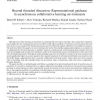5054 search results - page 975 / 1011 » How designers design and program interactive behaviors |
CE
2008
13 years 8 months ago
2008
Although most online learning environments are predominately text based, researchers have argued that representational support for the conceptual structure of a problem would addr...
KDD
2005
ACM
14 years 9 months ago
2005
ACM
Machine learning and data mining can be effectively used to model, classify and discover interesting information for a wide variety of data including email. The Email Mining Toolk...
OSDI
2002
ACM
14 years 9 months ago
2002
ACM
Combining high performance with low power consumption is becoming one of the primary objectives of processor designs. Instead of relying just on sleep mode for conserving power, a...
EUROSYS
2008
ACM
14 years 5 months ago
2008
ACM
Causal request traces are valuable to developers of large concurrent and distributed applications, yet difficult to obtain. Traces show how a request is processed, and can be anal...
ATAL
2009
Springer
14 years 3 months ago
2009
Springer
An important aspect of mechanism design in social choice protocols and multiagent systems is to discourage insincere and manipulative behaviour. We examine the computational compl...



